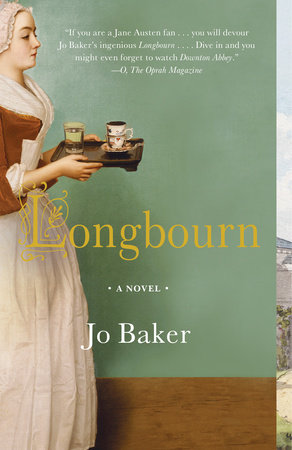Reading Group Center
- Home •
- Books by Category •
- Imprints •
- News •
- Videos •
- Media Center •
- Reading Group Center
Downstairs at Longbourn: The Bennet Sisters Through the Eyes of the Help
“It is a truth universally acknowledged, that a single man in possession of a good fortune must be in want of a wife.” So goes the famous first sentence of Pride and Prejudice, launching a story about Elizabeth Bennet and her sisters—their hopes and desires, fears and trepidations, infatuations and marriage prospects. These characters—gentle and pretty Jane, witty and vivacious Elizabeth, quiet but sanctimonious Mary, silly Kitty, and wild Lydia—are well-known to all from the pages of Austen’s timeless novel. Now, with Jo Baker’s Longbourn, an irresistibly imagined below-stairs response to Pride and Prejudice, we get a new perspective on the Bennet sisters through the eyes of their servants. From personal habits to social interactions, servants—like Longbourn’s housemaid Sarah—provide astute observations, adding color and texture to the familiar story.
Read on for a sampling of Sarah’s eye-opening assessments of the Bennet sisters and their different approaches in the matters of men and courtship. These snippets from the book can serve as a jumping-off point for a discussion of Longbourn’s characters—both upstairs and downstairs.
Jane Bennet
“Jane, well, she sat nicely, and smiled, and she listened with her head tilted, and replied politely when spoken to, and she always seemed quietly pleased to be spoken to, and to dance if she was asked to dance. But Jane was really very lovely indeed—a beauty, in fact.” (p. 22)
“Jane was sweet and beautiful, and so deserving of sweet and beautiful things.” (p. 166)
“Oil on troubled waters, Jane was: a blanket over flames.” (p. 18)
Elizabeth Bennet
“Elizabeth. She was a different, much more active, creature, when it came to dealing with gentlemen. Sarah had seen it at dinners, and at supper-and-cards, when she handed round the anchovy toasts. Elizabeth was always ready with a what-do-you-call-’em, a witticism. Brighteyed and quick and lovely, making the young men blush and stammer, and the old fellows smile and wish they were half their age, and that bit sharper in their wits.” (p. 22)
“Even to her long-accustomed gaze, Elizabeth was genuinely compelling: if she was in the room, you knew you were wasting your time if you looked anywhere else but at her.” (p. 51)
Mary Bennett
“[S]he was unfledged still, a shabby nestling, her plumage not yet grown.” (p. 23)
“Mary must be struggling to converse with [Mr. Collins]—Sarah could sympathize—too much time spent with books had not fitted her to be easy with herself, and other people. The young lady got up abruptly, and went to the window, and Mr. Collins got up too, looking relieved. He took the plate from Sarah and was profuse in his thanks, but then, with Mary there, did not know what to do with the cake after all.” (p. 138)
Lydia and Kitty Bennet
“Lydia and Kitty—whom Sarah sometimes struggled to think of as two separate persons, but saw instead as one collective creature of four limbs, two heads, and a bundle of frocks and ribbons—Kitty and Lydia always had a hum of men around them. Curl-tossing, a bold look. . . . They pitched themselves at every unmarried man who came their way, which made for rowdy card-parties and dances. Their approach required nothing more of a girl than enthusiasm, stamina and a copper-bottomed sense of self-importance. But really, did it amount to anything? Any man at all, gentle or otherwise, would surely be squeamish about attaching himself to a woman who had already flirted with every other man of her acquaintance.” (p. 22)


